Staff Photo
Little birds, big adventures: Six species of American quail beckon upland hunters. Pick a bird and go!
Click on a quail below to navigate to it's description:
Bobwhite Quail
An America original
By Jess McGuire
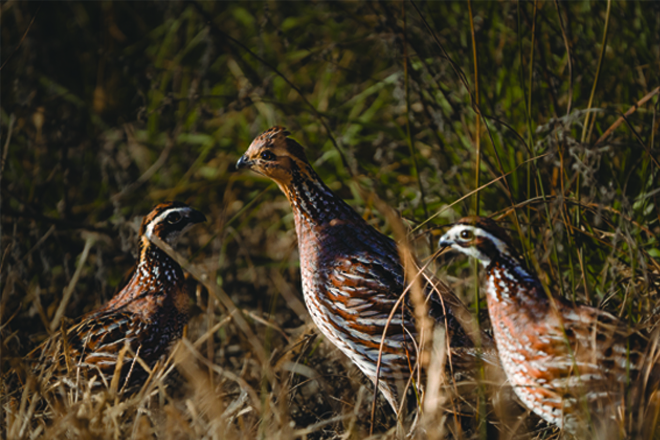 Photo by Anna Swerczek
Photo by Anna Swerczek
Nothing gets your heart pumping quite like the flush of a northern bobwhite quail. Their call floods the mind with nostalgia of that first hunt. This six-ounce bird is the catalyst for careers, the reason for long-standing family traditions, and the best reason to spend time with a four-legged best friend. Bobwhites are an American original.
The northern bobwhite range spans the eastern and central United States, historically north to Minnesota and south to Florida and Texas. What was once an easy bag to fill is becoming rarer and rarer as grasslands, old fields and wooded savannas decline. The central states of Nebraska, Kansas and Oklahoma are still a stronghold and perhaps the best bet for a traveling hunter.
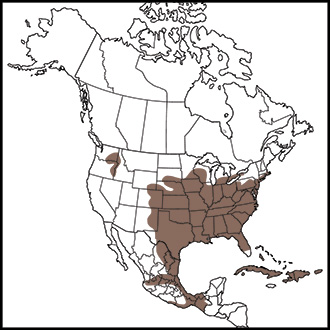
Bobwhite quail rely on mosaics of vegetative cover and habitat connectivity. Quail habitat must have three components to thrive throughout the year: nesting cover, loafing and escape cover, and brood cover with plenty of insects. This type of landscape is quickly vanishing throughout the bobwhite range. Quail Forever works to bring quail habitat back.
Landowners and land managers with goals for increasing bobwhite populations should have an even mix of weeds and legumes, shrubby cover and native warm-season clump grasses. One easy solution is to put the mower away before nesting season so the birds have a chance to safely head into the breeding season, nest and rear young.
Bobwhites are social, and covey formation is critical to quail surviving throughout the fall and winter. We hunt coveys, and appropriate winter cover and food sources are the keys to carrying those coveys into winter.
Habitat structure is key to hunting success. Morning covey calls can help you tune in success for the day. Open weedy fields, overgrown hedgerows and field borders are typical havens for a quail covey, which often means these are good places to run the dog.
For a unique experience, the longleaf pine savanna ecosystem is a favored habitat of bobwhites in the southeastern United States. The diversity of the forest floor in the longleaf pine ecosystem rivals the rainforest. Which is why such a fantastic suite of species call it home. More than 80 bird species utilize longleaf communities. The gopher tortoise also calls the longleaf floor home. Its burrow has been referred to by some as an “air raid shelter” for quail, offering protection from aerial predators and an escape from fire.
A number of state wildlife agencies have dedicated significant resources on public lands to create quail focal areas. Success stories are usually associated with the areas that have an emphasis on quail and have a prescribed fire program, intense brush management, and generously thinned forests with early successional openings scattered throughout.
The southeastern states rarely make the lists these days for hunting. However, many “quail focal areas” (including those on National Forests) in Georgia, South Carolina and Alabama are reporting increasing numbers of wild quail. Hunter feedback has been positive, which ultimately motivates for better management. Those central states mentioned are a good bet; look to well-managed public lands, and walk-in access areas.
The fate of the northern bobwhite, in addition to other upland species, is squarely in the hands of those that sit at the table and take to the field to fight for, and create and improve, habitat.
Dr. Jess McGuire is Science Coordinator - Grasslands & Savannas Framework for Quail Forever.
Gambel's Quail
Top-knotted little demons
By Chad Love
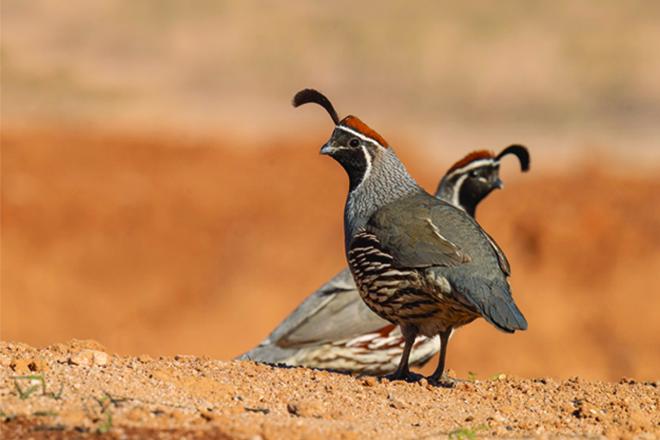 Photo by Lon Lauber
Photo by Lon Lauber
If you were to ask a dozen quail hunters what pops into their head when you say “desert quail,” for most it would likely be the fleet-footed, top-knotted Gambel’s quail, the quintessential desert quail of the Southwest.
This denizen of our arid southwestern environs (think roadrunner and Wile E. Coyote country) is a popular gamebird across its range, which covers parts of New Mexico, western Colorado, Utah, Nevada, California, Arizona and far West Texas.
These are fantastic little gamebirds, but they do offer some unique challenges to the first-time Gambel’s hunter, and that list doesn’t even include the obvious ones of terrain and temperature.
First, there’s the running. Much like the scaled quail, and the very similar-looking valley or California quail, Gambel’s quail are runners.
The first time I encountered Gambel’s quail while hunting in Arizona, I expected an upland gamebird, not a feathered comet. I was used to running quail. Western bobs run more than most people think they do, and scaled quail are notorious runners. But Gambel’s quail are at least the equal to a scalie for sheer ground speed.
So if you’ve never hunted Gambel’s, be prepared for some quick walking, and consider letting the dogs bust up a covey, then go hunt singles. Much like scaled quail, single Gambel’s do tend to hold a little better.
Speaking of coveys, that’s the second challenge about Gambel’s quail. Gambel’s coveys in good years can be giant, with legitimate 100-bird coveys possible. It’s old advice but good advice: Resist the temptation to flock shoot. Pick a single bird out of the maelstrom that is a Gambel’s covey rise, or you’ll be experiencing multiple misses while blasting futile holes in the sky.
And third, Gambel’s quail tend to hang out in some of the gnarliest areas of a region that’s already plenty gnarly. Thick stands of cactus and thorny desert shrub, cactus flats, boulder-strewn washes covered in vegetation … all just waiting to hurt you. Gambel’s quail inhabit a landscape that very much wants to see you in pain.
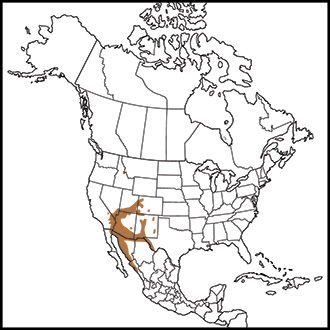
Add it all up, and the trifecta of foot speed, confusion through sheer numbers, and the difficulty of the terrain, can sometimes make these gorgeous little desert jewels seem like topknotted little demons. And I say that with admiration.
And there is also their unique appeal. Of all the quail species, the Gambel’s quail to me just seems the overall toughest. Mearns’ will make you scale higher hills. Scalies may make you run more. But Gambel’s will make you do both … and probably sweat and bleed in the process.
How can you not love a bird like that? There’s a place for easy birds, and then there’s a place for hard birds. The Gambel’s is a hard bird that thrives in a hard country. Hunt them just once and you’ll instantly develop a soft spot in your heart for these hard birds.
I certainly did. Like most traveling quail hunters, my first Gambel’s quail hunt was to mark them off my quail slam list. I didn’t expect to fall in love with such a punishing little demon that would lure me back year after year. But that’s exactly what they did.
Make a deal with this demon, and you may get hooked too.
Chad Love is editor at Quail Forever.
Scaled Quail
The blue streak
By Chad Love
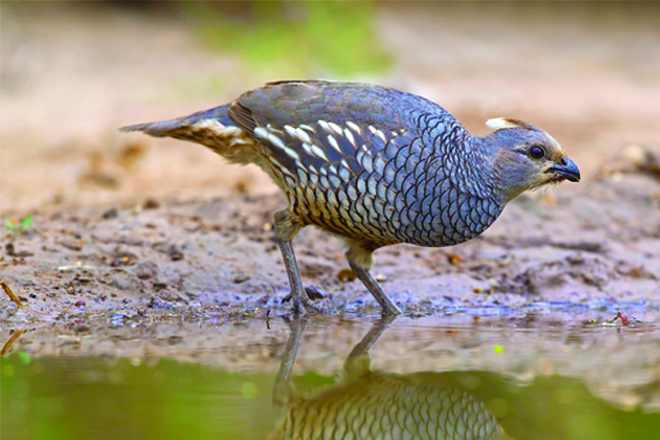 Photo by Gary Kramer
Photo by Gary Kramer
The point came at the end of a long double-time march across the hot and shimmering vastness of a sparsely vegetated mesquite flat. This was my young pointer’s first encounter with the fleet-footed tracksters which had, up this moment, deflected all efforts to pin them down.
She’d pointed, relocated, pointed, relocated, pointed and relocated herself across 400 yards of this grassy flat until finally she caught up with them. In the center of a gnarly mesquite thicket 10 feet off the end of her nose, the birds finally froze, then flushed, and Abbey notched her first scalie.
It certainly wasn’t what she was used to, but “not what you’re used to” is what you have to get used to with the scaled quail.
Whether you call them blues, cottontops, scalies or the taxonomically correct scaled quail, these denizens of the desert and near Southwest will test both you and your dog.
You will find scaled quail from far western Oklahoma and southwest Kansas and southeastern Colorado south across west Texas, New Mexico and eastern Arizona. They are birds of the desert grasslands generally found beyond the 100th meridian. Typical scaled quail habitat includes relatively flat, open country featuring sparse, low-growing grasses and vegetation like mesquite and cholla.
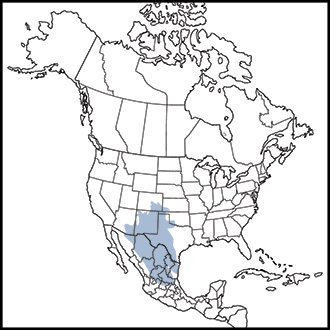
Perhaps it is a function of living in typically flat terrain with a lot of open ground and bare dirt, but scaled quail also love structure. Dilapidated, abandoned homesteads, old windmills and stock tanks, farm machinery and overgrown implements are good places on which to key.
Dense stands of cholla are another scalie magnet, as is a water source. Find a guzzler, stock tank or windmill with a pit pond that has some standing water, and you’ll likely find scaled quail nearby.
Start walking circles around these water sources, slowly expanding the circle and widening your search area with each pass.
Traditional dog work doesn’t always work in scaled quail country. While coveys will hold, they are just as likely to run, and run fast. Many quail hunters will allow their dogs to bust the covey, then hunt the singles that tend to hold tight.
Booting your dog is often a necessity in scaled quail country. Thorns, sharp rocks and sandburs are common across scaled quail range, and can stop a dog cold if not taken care of.
Lastly, you need to have some level of fitness to hunt the blue streak, because these quail are notorious runners and will flat outrun you if you let them. For most birds you need boot leather. But for scalies you need boot leather AND track shoes: boot leather to get far enough away from the road to find them, and track shoes to keep up with them when you do.
That pretty much sums up the scaled quail. As a noted outdoor writer once said, “The truth is, if you’re going to hunt scaled quail, humiliation is integral to the experience. That’s also, of course, why it’s so damn addictive.”
Chad Love is editor at Quail Forever.
Valley Quail
Anything but typical
By Jack Hutson
 Photo by Lon Lauber
Photo by Lon Lauber
The small setter labored to transect through the drainage thick with nine-bark and wild rose brush. Suddenly, and quite conspicuously, the commotion of Tess’s progress came to a halt.
I stepped into the margin of brush and startled a covey of quail. They buzzed out like bees in all directions! Still holding her ground after the initial commotion, Tess had one more pinned. To flush the bird and still have a shot would be a challenge.
Cautious tiptoeing through rock and briar ensued. Opportunities often come quick and unexpected. With a jolt, the little rooster busted sharply to my left. I pulled the barrels of the little .410 past the fleet bird. The first shot lifted a plume of feathers. The quail fluttered downward then dropped like a stone as the top-barrel bucked.
Time to retrieve, reload and search for singles.
A textbook example of a typical valley quail hunt out west? Perhaps. Yet “typical” is not a term easily applied to these excitingly sprite game birds. This exquisite-looking quail’s origins are in various river valleys and canyons along California’s coast, offering the rather unusual circumstance of also being known as California quail. Here in Idaho and eastern Washington we call them valley quail.
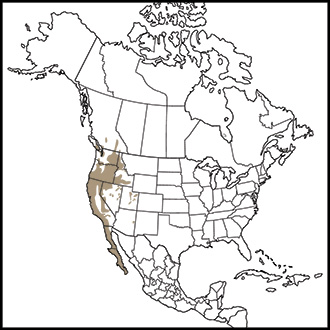
The most sought-after of its western cousins, Callipepla californica has reaped the benefits of popularity through extensive distribution.
By the early 1900s, through private and state game agency means, the valley quail had experienced widespread proliferation throughout the northwestern states, pockets of adequate habitat in other western states, and the Canadian province of British Columbia.
Riparian areas below 3,500 feet of elevation seem to be essential ingredients in a life sustained by a large variety of seeds, fruits, broadleaf plants and occasional insects.
These hearty quail are a major prey species for a host of predators. To combat its status as low critter on the food chain, valley quail have developed several effective survival strategies. To enhance reproduction, both parents rear mobile and quick-maturing young, which can sometimes allow for multiple nesting events in the same year.
Collectively, the valley quail’s unique adaptability has made it a most successful upland gamebird.
There are vast amounts of information available to help you locate these little bumble-birds. Start by contacting agencies such as the BLM, USFS and state land and game agencies.
Focus your search in drainages along major waterways. These areas are often held in trust for public access, and offer the conditions ripe for quail. Don’t overlook private lands open to public access. Search for the heads of watery draws — where brushy canyons meet farmed ground. Once there, look for blackberry or wild rose cover that provides both protection and food source.
Listen: Valley quail are vocal birds and are often found by their chatter and signature call: chi-ca-go.
From sage and basalt canyons to forested glens, a scenic backdrop is always part of the valley quail hunting experience. Their explosive covey flush and the tight-holding singles make them a favorite among hunters with pointing dogs and light guns in search of amazing upland game action.
Jack Hutson is neighbor to coveys of valley quail. He lives near Lewiston, Idaho.
Mountain Quail
Spice way up high
By Scott Linden
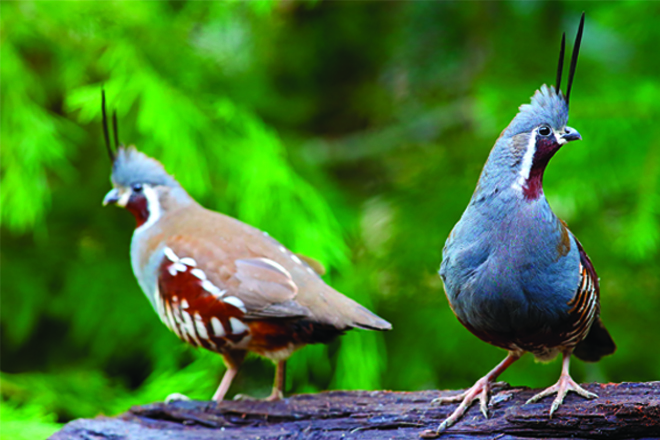 Photo by Gary Kramer
Photo by Gary Kramer
They marched like roly-poly soldiers, single file, plumes bobbing, across a mountain road, then vanished like water drops on a hot skillet. The first mountain quail I’d ever seen, and all I had with me were fly rods.
That’s an apt description of Oreortyx pictus … shape-shifting, mysterious, elusive … and a whispered call that’s vaguely familiar. And always, up high. Vertical terrain is to mountain quail what tallgrass and cattails are to ring-necked pheasants. The country is magnificent.
Maybe most intriguing, mountain quail share habitat, habits and appearance with other upland birds we pursue. Like a bite of chili in Kung Po chicken, they add spice to many hunts. An example:
My wirehair quivered, one foot in a tiny desert stream, nose pointed toward a bankside tuft of grass. I tip-toed across an old beaver dam until two birds erupted. One streaked toward me, the other towered like a woodcock. Only when delivered to hand did I learn it wasn’t a valley quail.
Rare and vividly colored, tall swept-back head plumes, a circus of brown-white-black stripes and patches, female and male mountain quail are almost identical. Fist-sized and a little more, North America’s largest quail is worth the scrapes and bruises you’ll suffer in pursuit, whether on purpose or as serendipity.
Favored habitat is steep, brushy, broken woodland, where you might find forest grouse. Mountain quail will move down in rough weather, but prefer elevations above 2,000 feet. I’ve also found them far from firs and rhododendron, among cattails with valley quail and in chukar country sagebrush and lava. Odds are best in the mountains though.
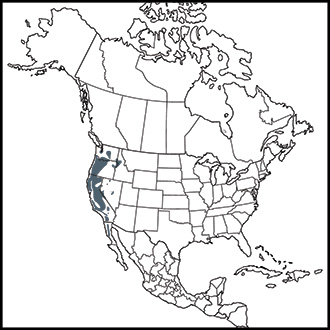
Grouse food is mountain quail food. They eat forbs, seeds, bulbs and berries. Coveys number five to 10, forming larger groups as winter nears. Like sharptails, more eyes and ears mean your chance of a realistic shot will plummet, so go early in the season.
Like chukars, mountain quail run uphill before flying downhill. Spread out and walk cross-slope: The uphill hunter may get a shot or push them back down to you. They run from under a pointer’s nose, and flushers whine as birds hunker in a blackberry thicket. A cocker walking at heel until you hear birds may flush them within range.
While these secretive birds inhabit mountainous chaparral in many mountain ranges west of the Rockies alongside ruffed, sooty and dusky grouse, savvy hunters cap their quail slam in national forests of southwest Oregon near Grants Pass. Southern California’s hills and coast range around Gorman can deliver, as can the Tahoe National Forest north of Truckee.
A paradox inside a conundrum, mountain quail blur lines between other gamebirds … where they live and how they behave. They are also hard to distinguish on the wing from their valley quail cousins, whose season and range sometimes overlap, but can be wholly different.
Knowledge of the terrain, habitat, regulations, distinguishing features and behavior are crucial before you unclip your dog’s lead. Maybe that’s the attraction of finding this needle in the gamebird haystack, this spice to a main course up high on a mountain. Odds are, it will come as a pleasant surprise and provide lifetime memories.
Oregonian Scott Linden takes his mountain quail hunting seriously as he pursues other birds.
Mearns’ Quail
Jewel of the sky islands
By Chad Love
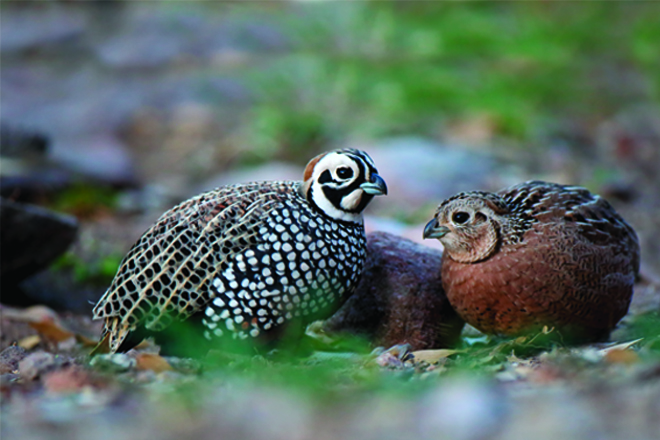 Photo by Gary Kramer
Photo by Gary Kramer
It is, by almost any metric, a singular bucket-list bird for everyone, this lovely little jewel of a bird that goes by Mearns’ to some, and Montezuma to others. Whatever the name, the allure remains for perhaps our most coveted quail species.
My first Mearns’ quail came on the side of a southern Arizona mountain that looked steep enough for chukar. My flatlands setter had adapted well to running contour lines, but I had not, and when he slammed into a point beneath a small oak tree I gasped and puffed my way to the spot.
Four birds rocketed out from beneath the oak’s canopy. One tumbled to the earth, and as I held that feathered gem in my hand, admiring its jaw-dropping beauty and tropical-looking plumage, I realized that I had just taken a true trophy of the upland world.
Mearns’ quail are often associated with the desert. However, they are not technically a desert bird, but rather a neotropical species that typically occupies the higher oak savanna grasslands above the true desert haunts of the Gambel’s and scaled quail.
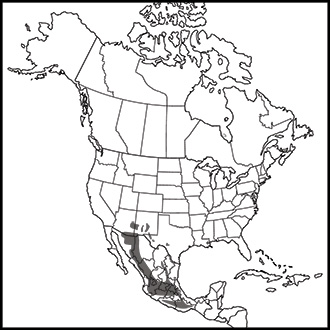
You will find Mearns’ quail in scattered populations across southern Arizona and southern New Mexico; there is also a small, non-huntable population in Texas. The majority of their range, however, is found in Mexico.
If they aren’t desert birds, then why are these birds here in the desert? In a word: elevation. The mountain ranges of the Southwest rise above the scorching desert floor, and with this elevation comes differing biomes and differing natural worlds called sky islands.
Here in these sky islands you will find the Mearns’ quail, digging with their elongated, scythe-like claws for tubers. In fact, “diggings” or areas of disturbed ground where Mearns’ quail have scratched in search of food, are prime indicators of their presence.
Summer monsoon rains are critical for Mearns’ quail production, and the population of these birds will rise and fall based on receiving the right moisture at the right time. Wet years mean more Mearns’ (because there is more grass), while dry years mean lean pickings for both birds and hunters. So If you plan on traveling to hunt Mearns’ in fall and winter, pay close attention to what’s happening in the summer.
Speaking of hunting, you are hereby advised to break in your boots and hit the treadmill, for you will often be side-hilling mountains and hills covered with grass, short-statured oak trees, and rocks of the perfect size and shape to roll ankles. This type of hunting is not like walking the back 40 or a CRP field. It can be exceedingly physical. Mearns’ quail are also famous for holding tight, so flushes will often come at your feet and after the dog has thoroughly worked an area.
Another thing you will notice about Mearns’ quail compared to other species is covey size. Mearns’ quail will generally have smaller coveys than the scaled and Gambel’s quail found down below them.
Smaller covey sizes mean it is important to not shoot out any one covey. Mearns’ quail have received a lot of interest from hunters in recent years, and an increasing amount of pressure. Take a bird and move on, and consider limiting how many you take during your hunt. Let’s make sure these jewels of the sky islands will always be here.
Chad Love is editor at Quail Forever.
This story originally appeared in the 2022 Upland Super Issue of the Quail Forever Journal. If you enjoyed it and would like to be the first to read more great upland content like this, become a member today!